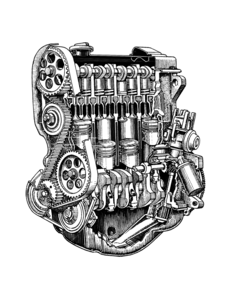TECH TIP: STOPPING DIESEL RUN ONA frequent complaint of diesels is running on, or running away, it can be a really exciting experience if your car runs on its own. You let off the end of the accelerator and your car accelerates faster. You turn your key off, and it continues to go and momentarily you feel powerless to shut it down. What your engine is doing is burning the oil out of the crankcase as fuel. Your car is sucking the oil out of the crankcase and consuming it; it is literally eating it. If your engine is running properly, there is a small amount of fumes coming out of your crankcase and rather than vent these fumes out to the atmosphere, these fumes are dumped into the air cleaner and burned along with the regular air which is pulled in through the air cleaner. Back in the 1950s all cars had a vent pipe, which just vented these fumes straight into the air. Cars ran forever, but sometimes you'd get behind a "smoker." Along came Ralph Nader who said that we were polluting our atmosphere and made the automakers vent this through the air cleaner into the engine and burn it to avoid dumping it out into the air. This system works fine, if everything is working fine, but many VW Diesels have excessive fumes coming from the engine which overloads the engine's ability to burn it and causes all sorts of problems. When the engine starts to use excessive oil, it can be caused by a number of things:
The problem is that you have excessive oil in the vapor and you are dumping this oil into the air cleaner. The "oil mist" clogs up the paper element in the air cleaner, which restricts the airflow into the engine and creates negative air pressure in the air cleaner. This negative air pressure sucks even more vapor, which compounds the problem. The quick and dirty solution is to disconnect the rubber line between the crankcase and the air cleaner. If your air cleaner never draws oily vapor, it will never clog the element with oil and will never run on due to crankcase oil being burned in your engine. Once you have disconnected this line, you basically have a 1950s style engine. It is running oil and oil vapor out onto the road behind it. The car will run like this forever and the engine will never run away, but it will smoke and drip oil. The solution to this dripping oil is to stick the hose into a gallon milk jug and wire the jug into your engine compartment somewhere and let the oil accumulate in the bottom of the jug and the vapor to go out between the neck and the hose. From here you can proceed to a more and more deluxe milk jug. You can take a 5,3 or 1 pound coffee can and place them upside down inside of each other, creating a baffle system. Bolt this somewhere in your engine compartment and put the hose into the innermost can and let the fumes come out through the gap between the biggest and second biggest cans. What you have built is an oil separator. You can buy a deluxe one like they use on INDY cars, made of stainless steel, for about $300.00 from any racecar manufacturer. It will even have a line and a check valve, which will drain the oil back into the crankcase. WARNING: While our customers have found this information useful, these articles/links are not from technical publications. Information presented here is to give you a general idea of what to do and how to do it. Auto repair, while fun and economical, can be dangerous. There is no way we can warn you of each and every hazard. How can we tell you that when installing a hub cap, don’t smoke and have a bucket of gas nearby? If you have no common sense, ignore these articles. Otherwise, read the warnings in the front of the Robert Bentley manual before you proceeded to follow any advice given here. |




